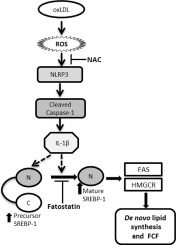当前位置:
X-MOL 学术
›
Cell. Signal.
›
论文详情
Our official English website, www.x-mol.net, welcomes your
feedback! (Note: you will need to create a separate account there.)
Sterol regulatory element binding protein (SREBP) -1 mediates oxidized low-density lipoprotein (oxLDL) induced macrophage foam cell formation through NLRP3 inflammasome activation.
Cellular Signalling ( IF 4.4 ) Pub Date : 2018-10-31 , DOI: 10.1016/j.cellsig.2018.10.020 Johnna F Varghese 1 , Rohit Patel 1 , Umesh C S Yadav 1
Cellular Signalling ( IF 4.4 ) Pub Date : 2018-10-31 , DOI: 10.1016/j.cellsig.2018.10.020 Johnna F Varghese 1 , Rohit Patel 1 , Umesh C S Yadav 1
Affiliation

|
Macrophage foam cell formation (FCF) has long been known to play a critical role during atherosclerotic plaque development. In the presence of atherogenic molecules such as oxidized low-density lipoprotein (oxLDL) macrophages accumulate massive amounts of lipid through uptake. However, in the presence of oxLDL mechanism of dysregulated lipid homeostasis in the macrophages remains largely unknown. Herein we have investigated the role of Sterol regulatory element binding protein (SREBP)-1 in oxLDL-induced inflammation and altered lipid homeostasis in macrophages. The U937 monocytes and monocyte-derived macrophages (MDMs) were stimulated with different doses of oxLDL. MTT assay to study the effect of oxLDL on cell viability, Oil-Red-O (ORO) staining to observe cytosolic lipid accumulation, semi-quantitative PCR and Western blotting to analyze mRNA and protein expressions, respectively, and spectrophotometric assay to measure the lipid synthesizing enzyme's activity were performed. Our results indicate that oxLDL increased proliferation in monocytes and decreased the viability in MDMs in a time- and dose-dependent manner. The oxLDL (100 μg/ml) enhanced lipid accumulation via increased expressions of SREBP-1 and its downstream proteins such as fatty acid synthase (FAS) and 3-hydroxy-3-methylglutaryl-CoA reductase (HMGCR) at both RNA and protein levels in monocytes as well as in MDMs. Inhibiting SREBP-1 by a synthetic inhibitor prevented excessive lipid accumulation by downregulating the expression of its downstream proteins. Further, oxLDL increased reactive oxygen species (ROS) levels, NLRP3 inflammasome activation and active interleukin 1β (IL-1β) release in both the cell types. The oxLDL-induced NLRP3 could be responsible for SREBP-1 and downstream proteins overexpression as siRNA silencing of NLRP3 decreased SERBP-1 levels. In summary, we have demonstrated that SREBP-1 could be a key player in oxLDL-induced excessive lipid accumulation leading to macrophage FCF via ROS-mediated NLRP3/IL-1β/SREBP-1 pathway.
中文翻译:

甾醇调节元件结合蛋白(SREBP)-1通过NLRP3炎性体激活介导氧化的低密度脂蛋白(oxLDL)诱导巨噬细胞泡沫细胞形成。
长期以来,巨噬细胞泡沫细胞形成(FCF)在动脉粥样硬化斑块形成过程中起着至关重要的作用。在存在致动脉粥样化的分子(例如氧化的低密度脂蛋白(oxLDL))的情况下,巨噬细胞会通过摄取积聚大量脂质。但是,在oxLDL存在的情况下,巨噬细胞脂质稳态失调的机制仍然未知。本文中,我们研究了甾醇调节元件结合蛋白(SREBP)-1在oxLDL诱导的炎症和巨噬细胞脂质稳态改变中的作用。用不同剂量的oxLDL刺激U937单核细胞和单核细胞衍生的巨噬细胞(MDM)。MTT分析法研究oxLDL对细胞生存力的影响,油红O(ORO)染色观察胞浆脂质蓄积,分别进行半定量PCR和Western印迹分析mRNA和蛋白质表达,并进行分光光度法测定脂质合成酶的活性。我们的结果表明,oxLDL以时间和剂量依赖性方式增加了单核细胞的增殖,并降低了MDM中的活力。oxLDL(100μg/ ml)通过增加SREBP-1及其下游蛋白质如脂肪酸合酶(FAS)和3-羟基-3-甲基戊二酰辅酶A还原酶(HMGCR)的表达而在RNA和蛋白质水平上增强脂质积累在单核细胞以及MDM中。用合成抑制剂抑制SREBP-1可通过下调其下游蛋白的表达来防止脂质过多积聚。此外,oxLDL增加了活性氧(ROS)的水平,NLRP3炎性小体激活和活性白介素1β(IL-1β)在两种细胞类型中均释放。oxLDL诱导的NLRP3可能是SREBP-1和下游蛋白过表达的原因,因为NLRP3的siRNA沉默降低了SERBP-1的水平。总而言之,我们已经证明SREBP-1可能是oxLDL诱导的过多脂质积聚的关键参与者,该脂质积聚通过ROS介导的NLRP3 /IL-1β/ SREBP-1途径导致巨噬细胞FCF。
更新日期:2018-10-31
中文翻译:

甾醇调节元件结合蛋白(SREBP)-1通过NLRP3炎性体激活介导氧化的低密度脂蛋白(oxLDL)诱导巨噬细胞泡沫细胞形成。
长期以来,巨噬细胞泡沫细胞形成(FCF)在动脉粥样硬化斑块形成过程中起着至关重要的作用。在存在致动脉粥样化的分子(例如氧化的低密度脂蛋白(oxLDL))的情况下,巨噬细胞会通过摄取积聚大量脂质。但是,在oxLDL存在的情况下,巨噬细胞脂质稳态失调的机制仍然未知。本文中,我们研究了甾醇调节元件结合蛋白(SREBP)-1在oxLDL诱导的炎症和巨噬细胞脂质稳态改变中的作用。用不同剂量的oxLDL刺激U937单核细胞和单核细胞衍生的巨噬细胞(MDM)。MTT分析法研究oxLDL对细胞生存力的影响,油红O(ORO)染色观察胞浆脂质蓄积,分别进行半定量PCR和Western印迹分析mRNA和蛋白质表达,并进行分光光度法测定脂质合成酶的活性。我们的结果表明,oxLDL以时间和剂量依赖性方式增加了单核细胞的增殖,并降低了MDM中的活力。oxLDL(100μg/ ml)通过增加SREBP-1及其下游蛋白质如脂肪酸合酶(FAS)和3-羟基-3-甲基戊二酰辅酶A还原酶(HMGCR)的表达而在RNA和蛋白质水平上增强脂质积累在单核细胞以及MDM中。用合成抑制剂抑制SREBP-1可通过下调其下游蛋白的表达来防止脂质过多积聚。此外,oxLDL增加了活性氧(ROS)的水平,NLRP3炎性小体激活和活性白介素1β(IL-1β)在两种细胞类型中均释放。oxLDL诱导的NLRP3可能是SREBP-1和下游蛋白过表达的原因,因为NLRP3的siRNA沉默降低了SERBP-1的水平。总而言之,我们已经证明SREBP-1可能是oxLDL诱导的过多脂质积聚的关键参与者,该脂质积聚通过ROS介导的NLRP3 /IL-1β/ SREBP-1途径导致巨噬细胞FCF。











































 京公网安备 11010802027423号
京公网安备 11010802027423号